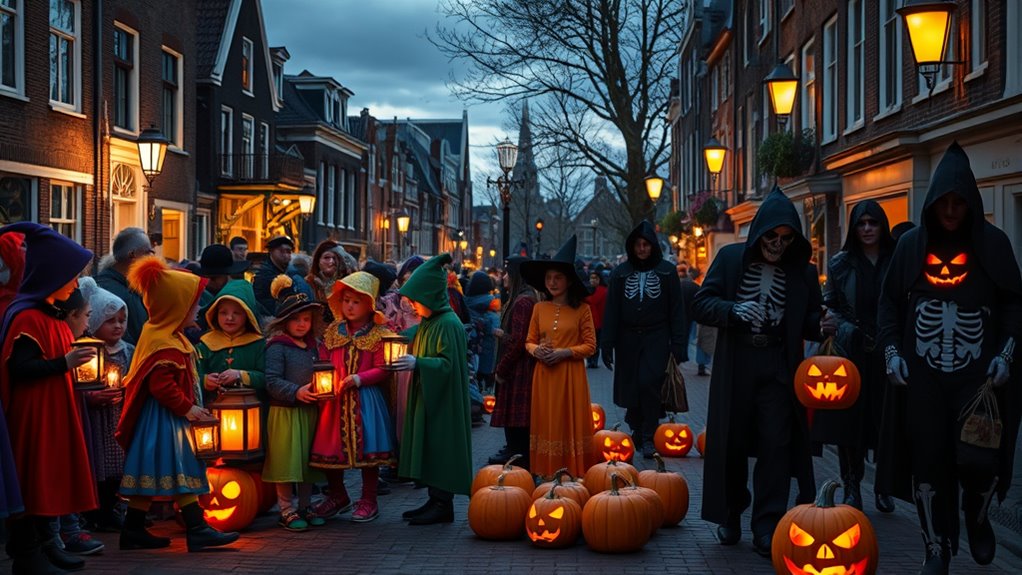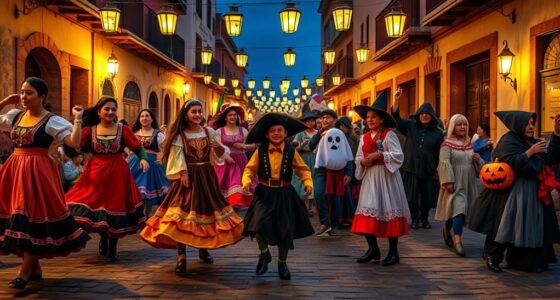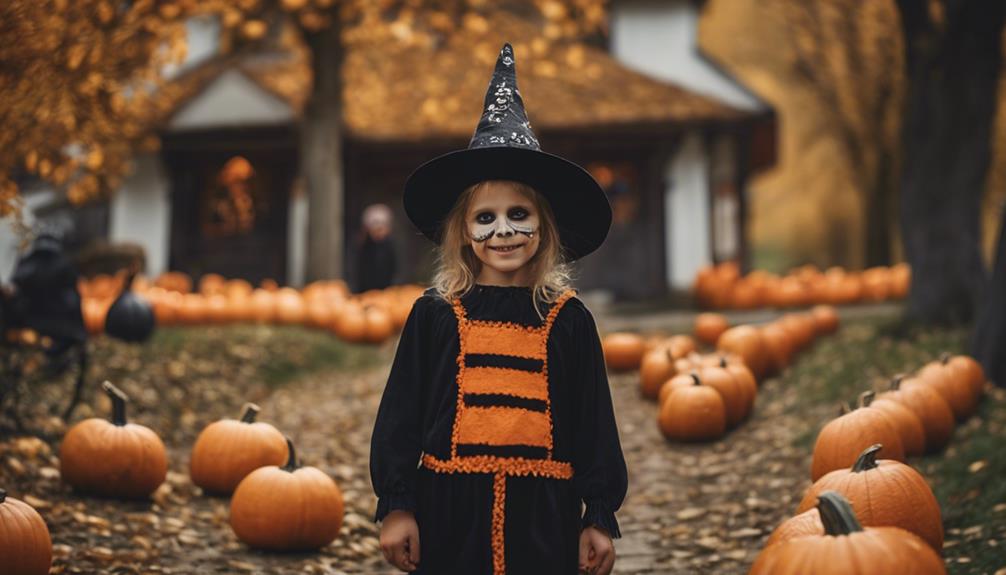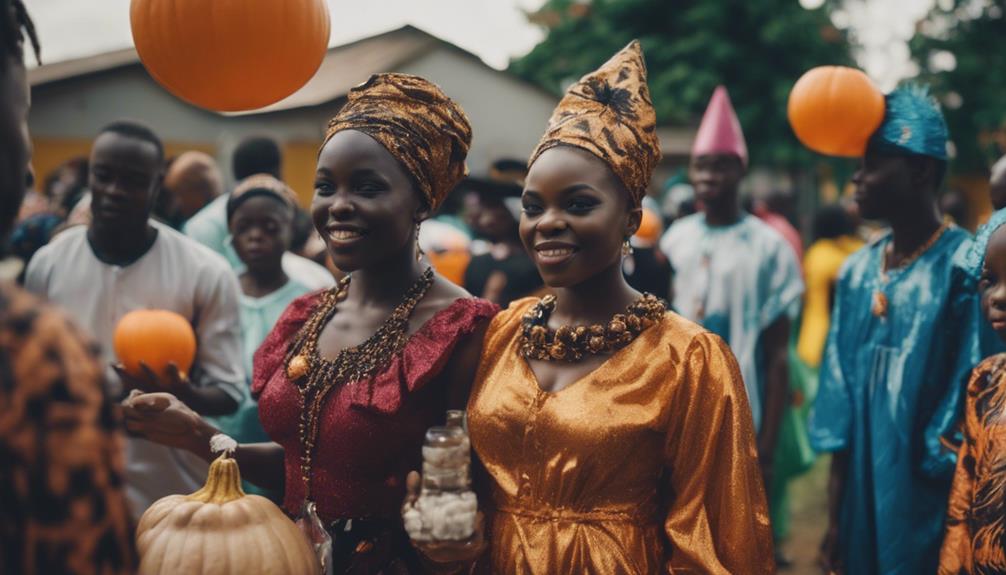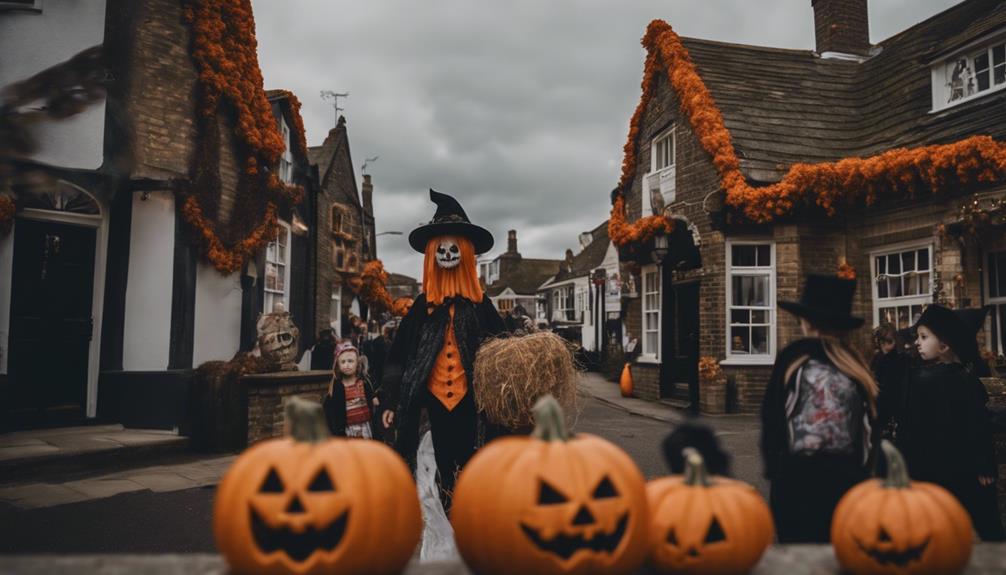In the Netherlands, St. Martin’s Day emphasizes tradition, community, and kindness, with children dressing in historical costumes and singing door-to-door for treats like coins or sweets. Halloween, on the other hand, focuses on fun, creativity, and spooky themes, with kids dressing as monsters, witches, or superheroes and enjoying trick-or-treating, decorations, and festive foods. If you explore further, you’ll discover how these celebrations uniquely reflect Dutch culture and values.
Key Takeaways
- St. Martin’s Day on November 11th emphasizes tradition, community, and kindness, with children in historical costumes singing door-to-door.
- Halloween, more recent in the Netherlands, focuses on fun, spooky costumes, trick-or-treating, and festive decorations.
- St. Martin’s Day features traditional foods like pea soup and treats such as marzipan, while Halloween offers candies, pumpkins, and themed baked goods.
- The festival atmosphere for St. Martin’s Day is reflective and community-centered, contrasting with Halloween’s lively, playful, and spooky vibe.
- Both celebrations showcase Dutch cultural traditions: St. Martin’s emphasizes reflection, and Halloween highlights creativity and entertainment.

Ever wondered how two festive traditions—St. Martin’s Day and Halloween—bring such vibrant energy to the Netherlands? As you explore these celebrations, you’ll notice that they each have unique customs, costumes, and foods that make them special. St. Martin’s Day, celebrated on November 11th, centers around themes of kindness and community. You’ll see children dressed in traditional costumes, often portraying St. Martin himself or other historical characters. These costumes are colorful and detailed, reflecting the local customs and historical attire. During the evening, children go door-to-door singing songs, much like Halloween trick-or-treating, but instead of candy, they’re often rewarded with small treats or coins. The celebration also features festive foods, with families gathering to enjoy hearty meals like pea soup or sweet treats such as marzipan and gingerbread. These foods create a warm, communal atmosphere, emphasizing sharing and generosity. Incorporating traditional costumes and historical attire adds authenticity and cultural richness to the festivities.
Halloween, on the other hand, has gained popularity more recently, especially in urban areas. It’s a night when you see streets filled with kids and adults alike dressed up in spooky, funny, or creative costumes. Unlike the traditional costumes of St. Martin’s Day, Halloween costumes tend to be more fantastical—witches, vampires, superheroes, and monsters. The focus is on fun and fright, and you’ll find houses decorated with cobwebs, pumpkins, and eerie lighting. Trick-or-treating is the main activity, and children passionately roam neighborhoods, collecting candies from neighbors who often go all out with their decorations. The festive foods associated with Halloween include candy, chocolate, and themed treats like pumpkin-shaped cookies or caramel apples. These sweet indulgences create a playful, slightly spooky vibe, encouraging everyone to get into the spirit of the holiday.
While both celebrations involve costumes and festive foods, their atmospheres are quite different. St. Martin’s Day feels more rooted in tradition, community, and reflection, with a focus on kindness and sharing. Halloween, meanwhile, is more about fun, creativity, and a bit of spookiness. Yet, you’ll find that in the Netherlands, both festivals offer a wonderful way to connect with local culture and enjoy lively, colorful experiences. Whether you’re participating in the traditional processions and singing or dressing up in costumes to scare or entertain, these celebrations give you a chance to immerse yourself in Dutch festivities, each with its own charm and flavor.
Frequently Asked Questions
How Do Children in the Netherlands Typically Celebrate St. Martin’S Day?
On St. Martin’s Day in the Netherlands, children typically celebrate by making and carrying Martin’s lanterns, which light up the evening. You’ll see charity processions where kids walk through neighborhoods, singing songs and sharing treats. It’s a warm, communal event that emphasizes kindness and giving. You might join in helping children prepare their lanterns or participate in the processions, enjoying the festive atmosphere and the sense of community.
Are There Any Unique Dutch Halloween Traditions Not Found Elsewhere?
They say “variety is the spice of life,” and Dutch Halloween traditions certainly prove that. Unique Dutch customs include themed parades, lantern processions, and trick-or-treating with a local twist. While inspired by Dutch harvest festivals and Sinterklaas customs, they blend spooky elements with cultural heritage. These traditions offer a distinct experience, making Dutch Halloween truly special—showing how the Netherlands adds its own flavor to this global celebration.
How Do Dutch Families Choose Between Celebrating St. Martin’S Day or Halloween?
You might notice Dutch families choosing between St. Martin’s Day and Halloween based on a cultural shift and their holiday preferences. Some prefer the traditional way of celebrating St. Martin’s Day, focusing on giving and community, while others enjoy Halloween’s festive costumes and spooky fun. Your choice depends on what aspects of tradition or modern celebration resonate most with your family, shaping how you participate in these festive occasions.
What Are Traditional Foods Associated With St. Martin’S Day in the Netherlands?
On St. Martin’s Day in the Netherlands, you’ll enjoy traditional pastries like sweet, spiced buns called ‘St. Martin’s bread’ and apple desserts. Families often gather to share festive beverages such as mulled wine or hot chocolate. These foods and drinks create a cozy, celebratory atmosphere, marking the holiday’s warmth and community spirit. Indulging in these treats helps you connect with Dutch customs and enjoy the seasonal festivities.
How Has the Popularity of Halloween Grown in the Netherlands Over Recent Years?
Like a rising tide, Halloween’s popularity in the Netherlands has grown steadily, fueled by increasing commercialization and trendy costume choices. You’ll notice more shops marketing spooky decorations and themed parties each year, making Halloween feel less like an outsider and more like a local tradition. This shift reflects changing attitudes, where the excitement of dressing up and celebrating the spooky season now rivals older customs, blending tradition with modern festivities.
Conclusion
So, as you’ve seen, in the Netherlands, St. Martin’s Day feels like a cozy, meaningful tradition, while Halloween’s just a spooky, commercialized party. Ironically, one celebrates kindness and sharing, and the other, costumes and candy. Maybe it’s fitting—you get to choose between a heartfelt feast or a night of frights. Either way, you’re bound to have a memorable night, just depending on whether you prefer warmth or scares. Who knew traditions could be so contrasting?
